All About Cooking Thermometers
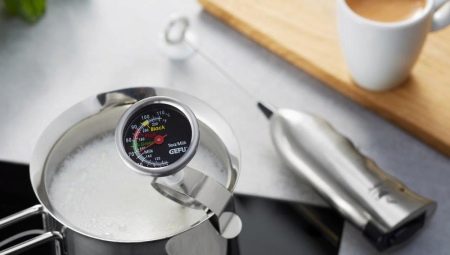
Lack of experience in cooking can be compensated for by strict adherence to the standard recipe. Equally important is the use of suitable cooking equipment. Culinary thermometers also deserve attention - they need to be discussed separately.
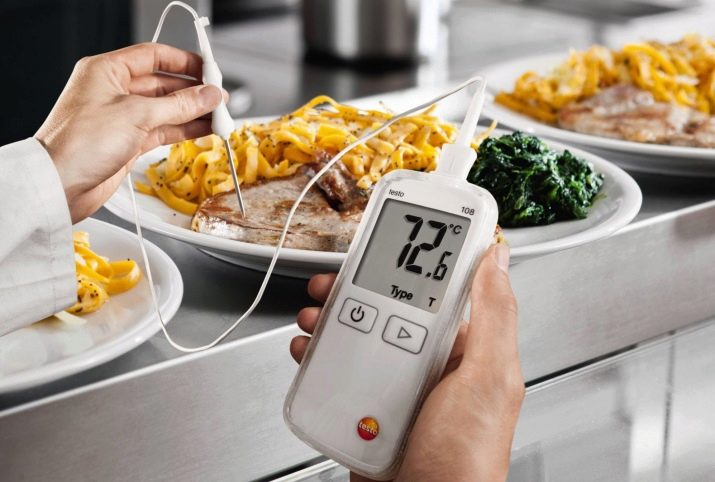
What it is?
A professional culinary thermometer is designed to maintain a strictly set temperature when cooking various dishes. If this regime is not respected, no amount of cookery diligence, no quality ingredients and spices with sauces will help. When preparing food, highly skilled chefs cannot always accurately catch the real warming up by eye. It is difficult to recognize it outwardly, and every culinary situation is individual. No experience can make a correct assessment.
To avoid an undercooked or overcooked dish, a kitchen thermometer is used. There are various models of these devices, including those designed for liquids. Still, they are more often used to measure the temperature of meat and fish.
A special temperature must be created inside solid products, which allows you to enjoy the optimal taste and prevents the growth of pathogenic organisms. However, there are a number of nuances and subtleties that must be taken into account when choosing an accessory.
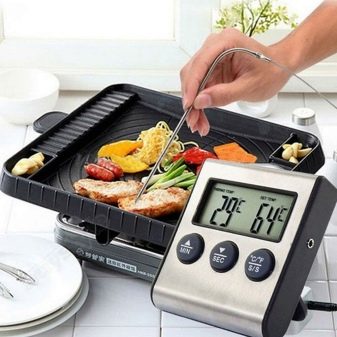
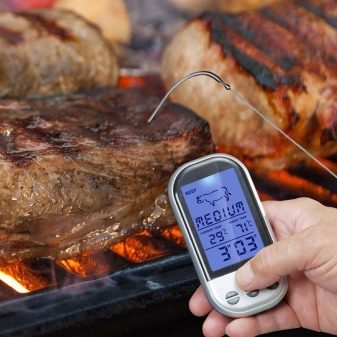
Advantages and disadvantages
So, among the positive aspects the acquisition of a culinary thermometer can be called:
- maintaining optimal taste and consistency;
- prevention of food spoilage;
- saving time and resources;
- faithful help to novice chefs.
Contrary to popular belief, these devices are not limited to fine dining.Even the most common home chefs can use them. It will be possible to determine how hot the empty pan is. The thermometer will also help determine when the dish is ready.
There is only one minus (only conditional) - the development of cooking experience may slow down somewhat.
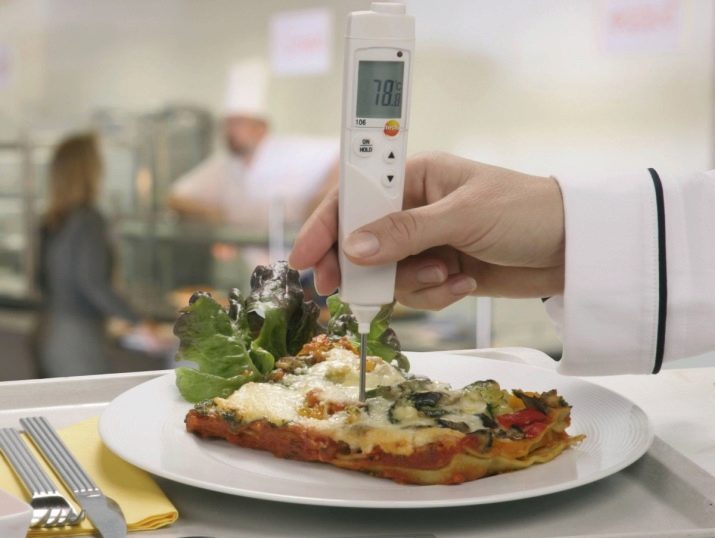
Varieties
A cordless immersion thermometer (also called a thermoprobe-needle) is quite often used. Outwardly, this device looks like a device with a display equipped with a steel spoke. It is very convenient to use such a device. Wireless systems are always at hand and, if necessary, can be used to measure the temperature of all dishes. A special feature of the model is the plastic case.
It should also be noted that the internal parts are too sensitive to heat. They can be damaged if the thermometer is constantly warming up. Problems are sometimes associated with displays - in budget class models, they are too capricious.
Not all food can be taken outside for temperature measurements. Yeast baked goods will definitely suffer from this treatment.
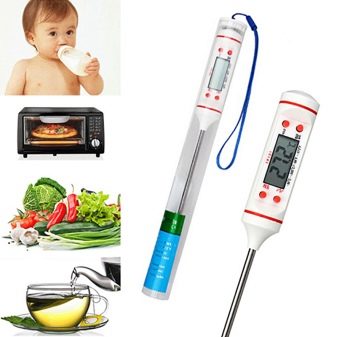
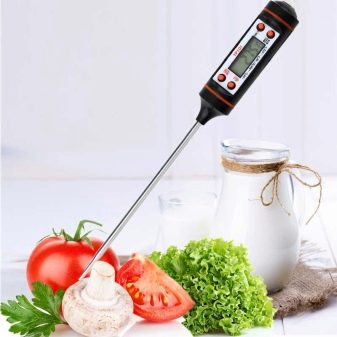
Another type of non-contact electronic thermometers for food is a laser meter. Strictly speaking, the laser is not used to measure temperature, but to precisely indicate the place where it is determined. Usually, power is supplied with batteries.
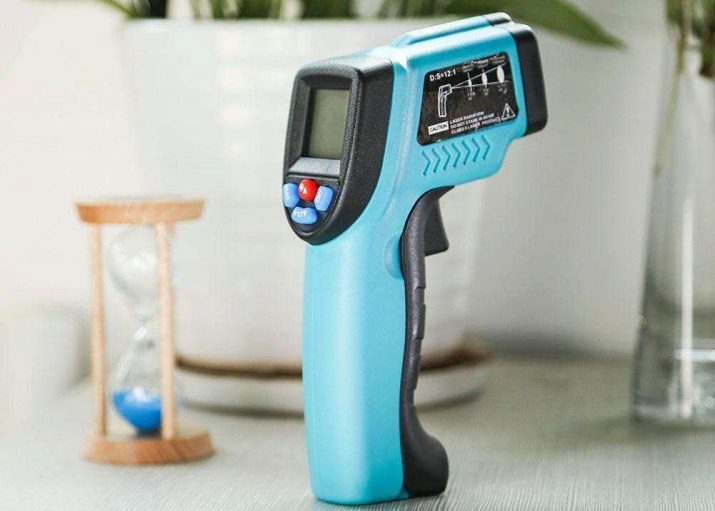
Devices with a remote sensor also deserve attention. During operation, the device itself is in a safe place. Signals from the needle are transmitted to the electronic system via a special flexible wire.
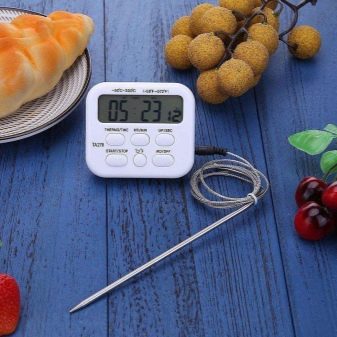

But even the best and most reliable wires can get tangled, broken. If this is critical, you should pay attention to the infrared type of thermometers. The absence of direct contact with the product is the safest. Measurement is carried out in real time, while cable devices give a delay of 3 to 5 seconds. Let this not be reflected in the result, but it can be pretty annoying to people.
Due to the elimination of physical contact with food, the thermometer does not have to be washed. But there are also problems - in particular, such devices are unable to determine what temperature is reached inside the piece. It will be possible to measure only on the surface of the dish. In addition, heat radiation probes are only capable of working from a distance of several meters under ideal conditions. And one more significant disadvantage is the high price (not less than 1,300 rubles).
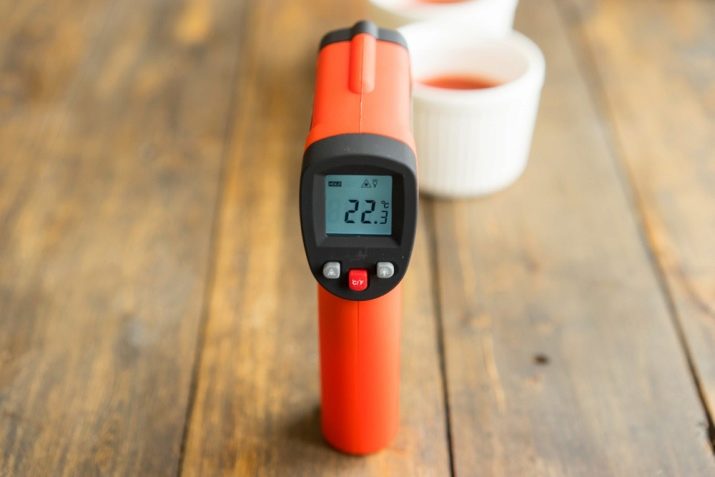
If you do not limit yourself to digital non-contact probes, you can take a closer look at mechanical devices. Such equipment works due to the long-known effect - the expansion of objects when heated. Plates of two different metals push the arrow in a certain way. By looking at the dial, you can immediately tell if the dish is ready. The liquid culinary thermometer is almost the same as its medical counterpart, with the exception of a much wider range of measured values.
Physically, all types of probes are equally accurate. However, difficulties can arise when reading the measurement results. So, the creators of mechanical thermometers are forced to find a balance between the range of measured temperatures and the level of errors. Using a scale, including with a liquid column, it is almost impossible to get around this problem.
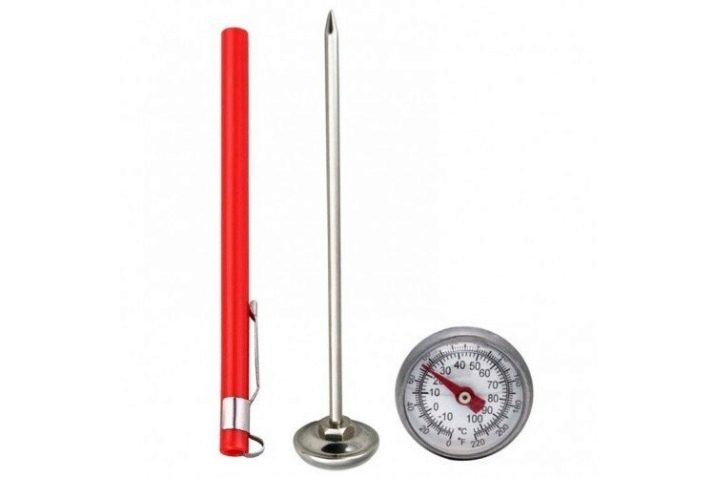
The digital waterproof penetration thermometer measures the temperature very accurately from the beginning (of course, if it is done efficiently).
However, another nuance appears here - if handled carelessly, the electronic filling can provoke malfunctions. In such a situation, the device will either completely stop working, or will demonstrate completely unrealistic numbers. The culinary pyrometer deserves special attention. Recently, these devices have become significantly cheaper than before. And their assortment has increased.
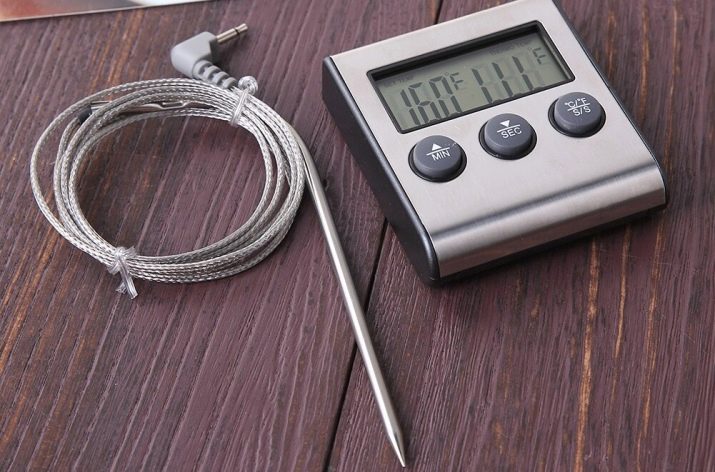
How to choose?
When choosing a food thermometer for the kitchen, you cannot be guided only by its simple device and reliable operation.Much more important is another circumstance - what dishes are mainly to be prepared at home. Fans of not only pastry shops, but also a wide variety of dishes should purchase thermometers with a range of 40-200 degrees. Specialized meat probes show temperatures from 60 to 120 degrees Celsius. But these devices will also help determine the degree of warming up and readiness:
- bread and bakery products;
- dairy starter culture;
- infant formula;
- water for bathing children.
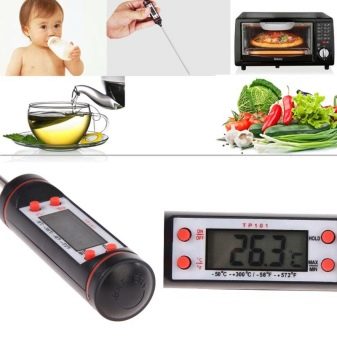

The most versatile thermometers for ovens. The upper mark of the temperature in them can reach 200-300 degrees. Some models are even designed to measure negative temperatures. They are needed by those who often bake meat, preserve food, or freeze and thaw food. Otherwise, there are almost no special differences between individual versions, and you need to pay attention to the properties of a particular model.
Experts advise buying kitchen thermometers directly from stores. Internet sites do not allow the thermometer to be rotated by hand. It will not be possible to accurately assess the perfection of the assembly and the strength of thin probes.
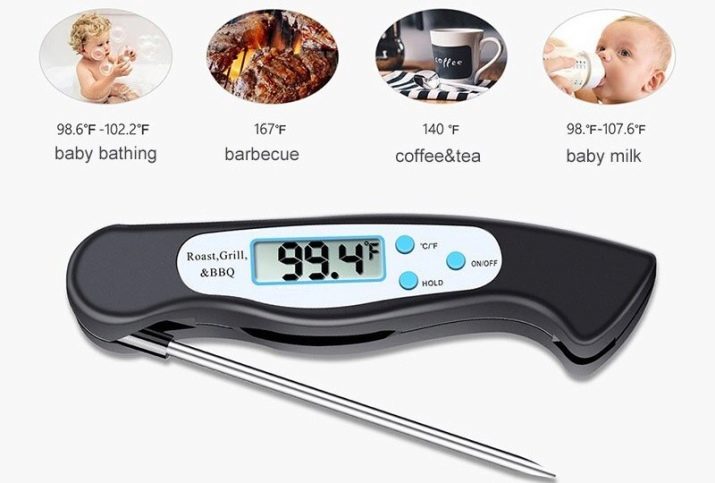
It is absolutely worth abandoning inexpensive digital versions, the error of which is too large. Even solid analog devices are much more practical. One more nuance - thermometers are better suited, allowing you to correct the readings.
They are not only used by professionals. Even very high quality probes that are actively used may not work properly. If they cannot be reconfigured, this will only cause additional chagrin. Experts strongly recommend giving preference to products from leading companies that value their reputation and will not allow marriage.
Of course, you should carefully study all reviews of a particular model on independent sites.
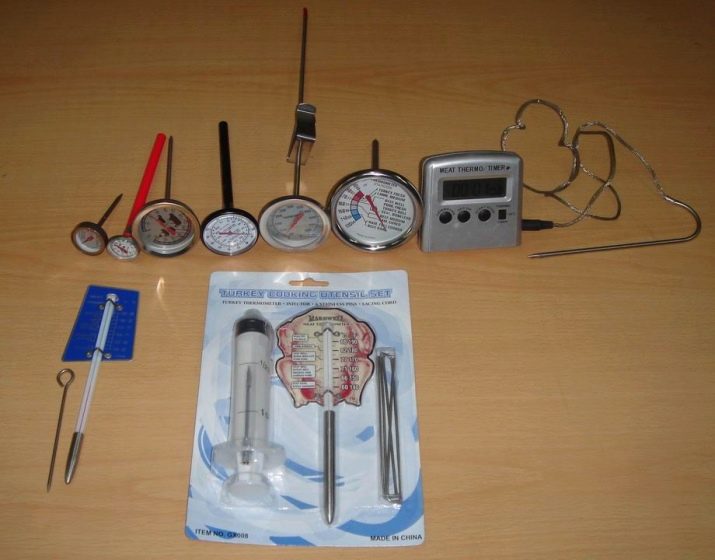
Manufacturers overview
According to experts, almost all the best thermal probes of the current state of the art contain only digital components. Considered a good choice Sinometer TP-3001 model... This thermometer measures temperatures from -50 to +300 degrees Celsius. A sharp probe can penetrate 15 cm into meat pieces. It is also allowed to measure the temperature in a layer of water or other liquids.
The scale range is 0.1 degrees, but the tolerance is 1 °. The advantages of the model are:
- minimum waiting time (the result is displayed already in 2 seconds);
- Fahrenheit measurement option;
- storage of intermediate values in the built-in memory.
Despite its positive properties, TP-3001 is sold inexpensively - no more than 500 rubles.
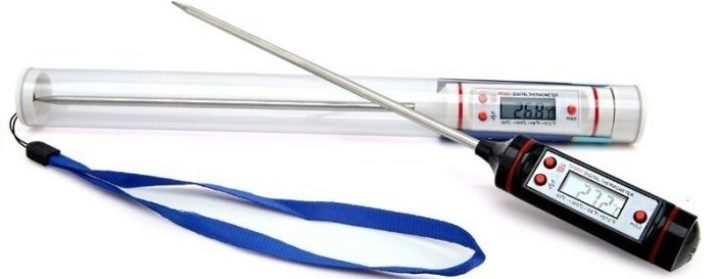
Thermometer similar in parameters Vigor HX-8220... The increased cost is justified by the stainless steel case. The cylindrical sealed device can be left in a pot of water without fear of damage when heated. The screen is backlit, and even a "relatively narrow" measurement range (from -40 to +200 degrees) is quite acceptable for working with meat.
Many advanced versions of external thermometers are equipped with:
- timers;
- program blocks;
- color coding of readiness;
- sound signaling devices.
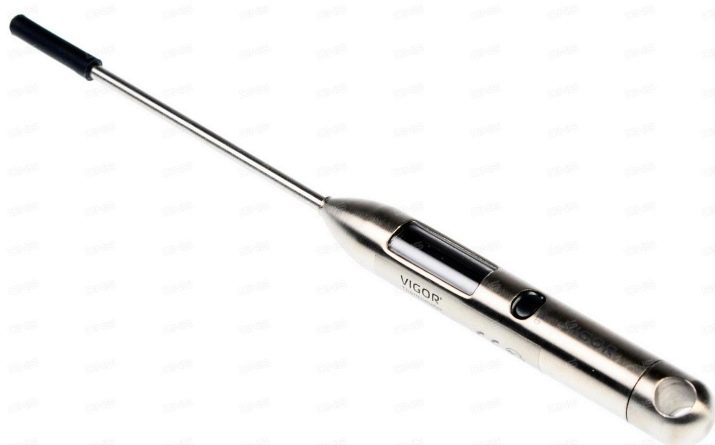
A striking example is Thermo TM1059... The device operates in the range from -50 to +300 degrees. The timer allows you to select a time interval within 99 hours. The 0.7 m wire makes the device as convenient as possible to use. The dipstick is made of stainless steel grades, it is very easy and simple to clean.
Separately, it is worth talking about radio probes. They have functionality that is not limited to measuring temperature.
The design includes a permanent meter with a built-in radio transmitter. Signal transmission is possible within a radius of 1000 m. The device will satisfy those who, while working in the kitchen, often go to the store or for other purposes; there are usually spare second course probes and auxiliary programs.
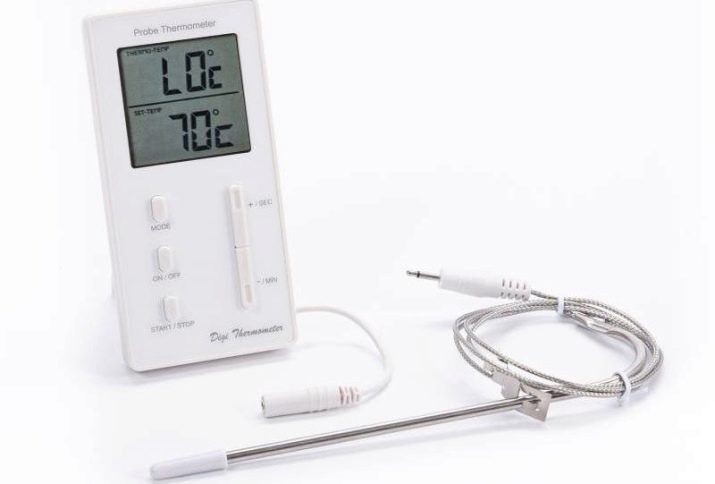
Terms of use
In general, it is not difficult to use culinary thermometers.Be sure to read the instructions and technical data sheet. But a lot can be said without instructions. So, pyrometers are used only to measure the temperature on the surface of food. This is very convenient, but not at all suitable for cooking meat.
Good thermometers need to be calibrated. To do this, they are immersed in melted or boiling water and the settings are set accordingly. Important: you should double-check the accuracy of the device readings at least once every 30 days. If the device is equipped with an audible alarm, you must stop cooking immediately, as soon as a characteristic signal sounds. It is also useful to take into account the standard table of temperatures for ready meals:
- beef should be warmed up to a maximum of 75 and a minimum of 65 degrees;
- for pork, the allowable range is 85 to 90 degrees (with slight deviations);
- poultry meat must be warmed up to 95 ± 3 degrees;
- lamb is recommended to be warmed up to 85 degrees Celsius.
The thermometer is inserted into the meat at the last stage of cooking. The rods are advised to be inserted as deeply as possible. This will allow you to more accurately determine the state in the center of the piece. It is strictly unacceptable to touch the probe with fatty inclusions, bones and cartilage. These parts may not be at the same temperature as the bulk of the pulp.


Too many samples are not recommended. Each puncture provokes the outflow of juice. As a result, despite strict adherence to the thermal regime, the meat can be overdried. The barbecue temperature is measured during the last 10 minutes of cooking, and for whole meat cuts - a maximum of 20 minutes before the end of the work. Unacceptable:
- drop the device;
- use it in any environment that is not specified in the instructions;
- expose to open flames;
- use at obviously inappropriate temperatures;
- use batteries not provided by the manufacturer;
- change the design in any way or try to repair the device yourself.
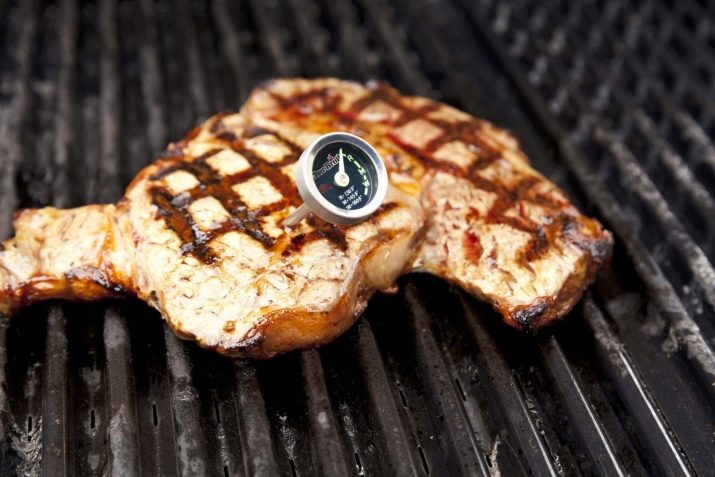
Care features
Even non-contact devices used in the kitchen can quickly become clogged. But washing in water, especially completely immersed in water, can only be specially specified by the manufacturer parts. On average, every 6 months it is required to check how accurately the readiness of the dishes is determined. For cleaning thermometers, as well as their screens, use only a slightly damp soft cloth. It would be even more correct to use special napkins.
Removable or retractable dipsticks can be washed in water. Important: after this, the part must be wiped dry. Store the thermometer where there is good ventilation but no direct sunlight.
It is necessary to wash and clean the working part of the device whenever, instead of one product, it is necessary to measure the temperature of another component. In the event of the slightest damage, you must immediately contact a specialist, without trying to solve the problem yourself.
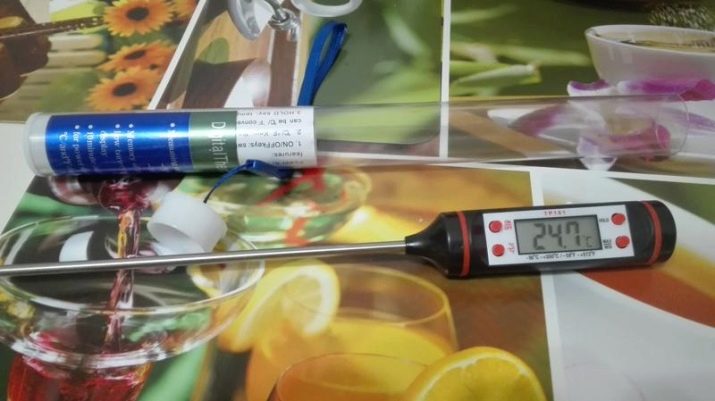
For an overview of culinary thermometers, see the following video.








